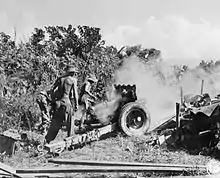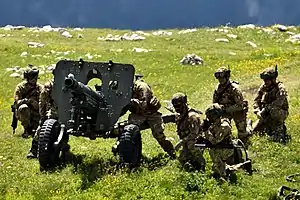Mountain gun
Mountain guns are artillery pieces designed for use in mountain warfare and areas where usual wheeled transport is not possible. They are similar to infantry support guns, and are generally capable of being broken down into smaller loads (for transport by horse, human, mule, tractor, and/or truck).

Due to their ability to be broken down into smaller "packages", they are sometimes called pack guns or pack howitzers. During the American Civil War these small portable guns were widely used and were called "mountain howitzers."
The first designs of modern breechloading mountain guns with recoil control and able to be easily broken down and reassembled into highly efficient units were made by two Greek army engineers, P. Lykoudis and Panagiotis Danglis (after whom the Schneider-Danglis gun was named) in the 1890s.
Mountain guns are largely outdated, their role being filled by howitzers, mortars, multiple rocket launchers, recoilless rifles and missiles. Most modern artillery is manufactured from light-weight materials and can be transported fully assembled by helicopters.
See also
Images
 80 mm French mountain gun with a 130-pound air mine attached c. 1915
80 mm French mountain gun with a 130-pound air mine attached c. 1915
Norwegian 6-pounder muzzle-loading mountain cannon of 1848 
British Indian Army crew assemble a 2.5 inch muzzle-loading "screw gun" c. 1895 
Mule transport of barrel of US Army 75 mm pack howitzer c. 1916 
German crew using a Skoda 75 mm Model 15 as an improvised anti-tank gun, 1918 
Germany army pack transport of gun wheels, 1942 
British 3.7-inch mountain howitzer crew in action in Burma, 1944 
Spanish Marines manning an Oto Melara 105 mm pack howitzer in 1981 
External links
| Wikimedia Commons has media related to Mountain artillery. |
- Popular Science, May 1941, "The Old Army Army Mule Takes Guns Where Wheels Won't Go"
- Assembling the Howitzer detail photos showing a 75mm howitzer's various sections being taken off mules and assembled